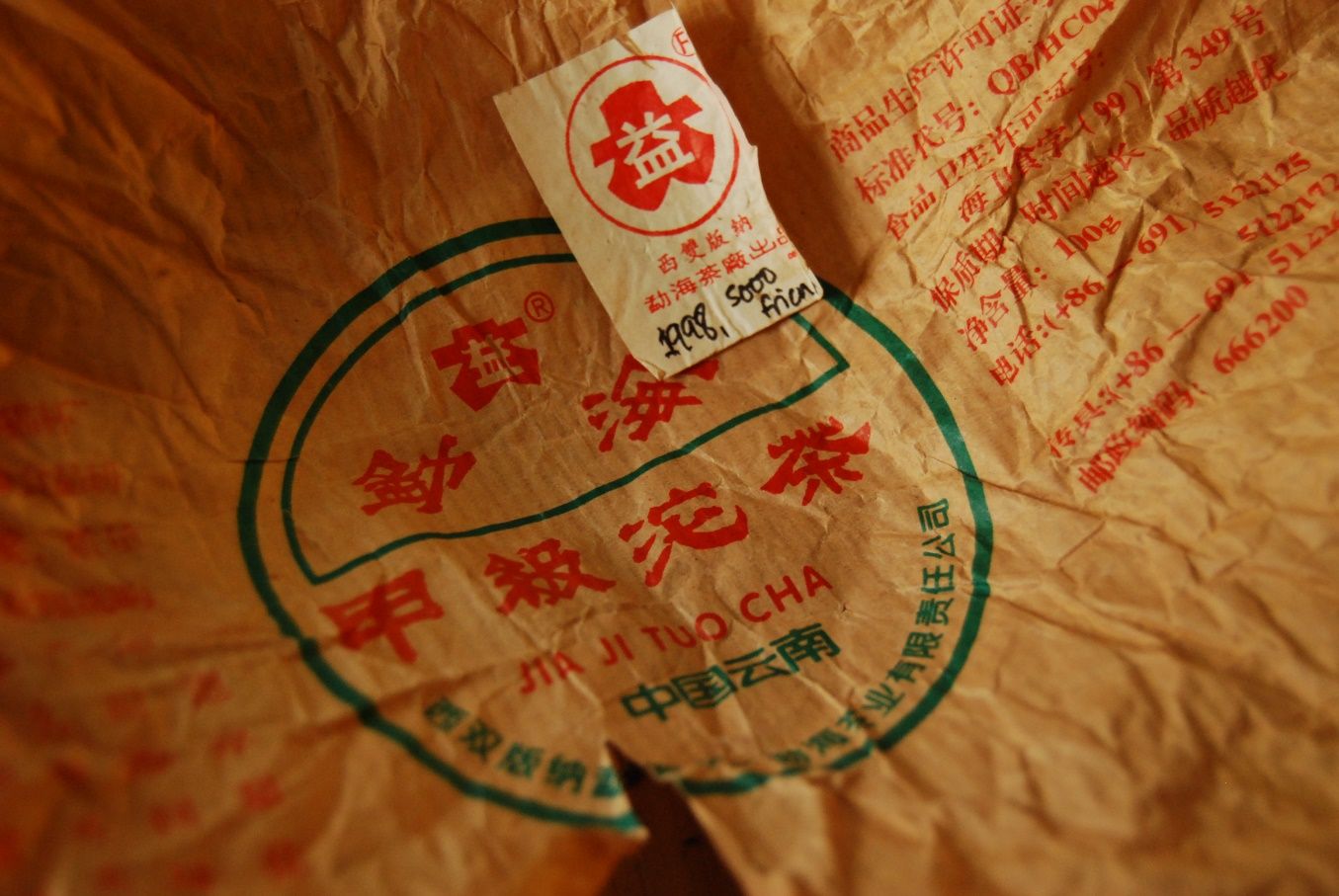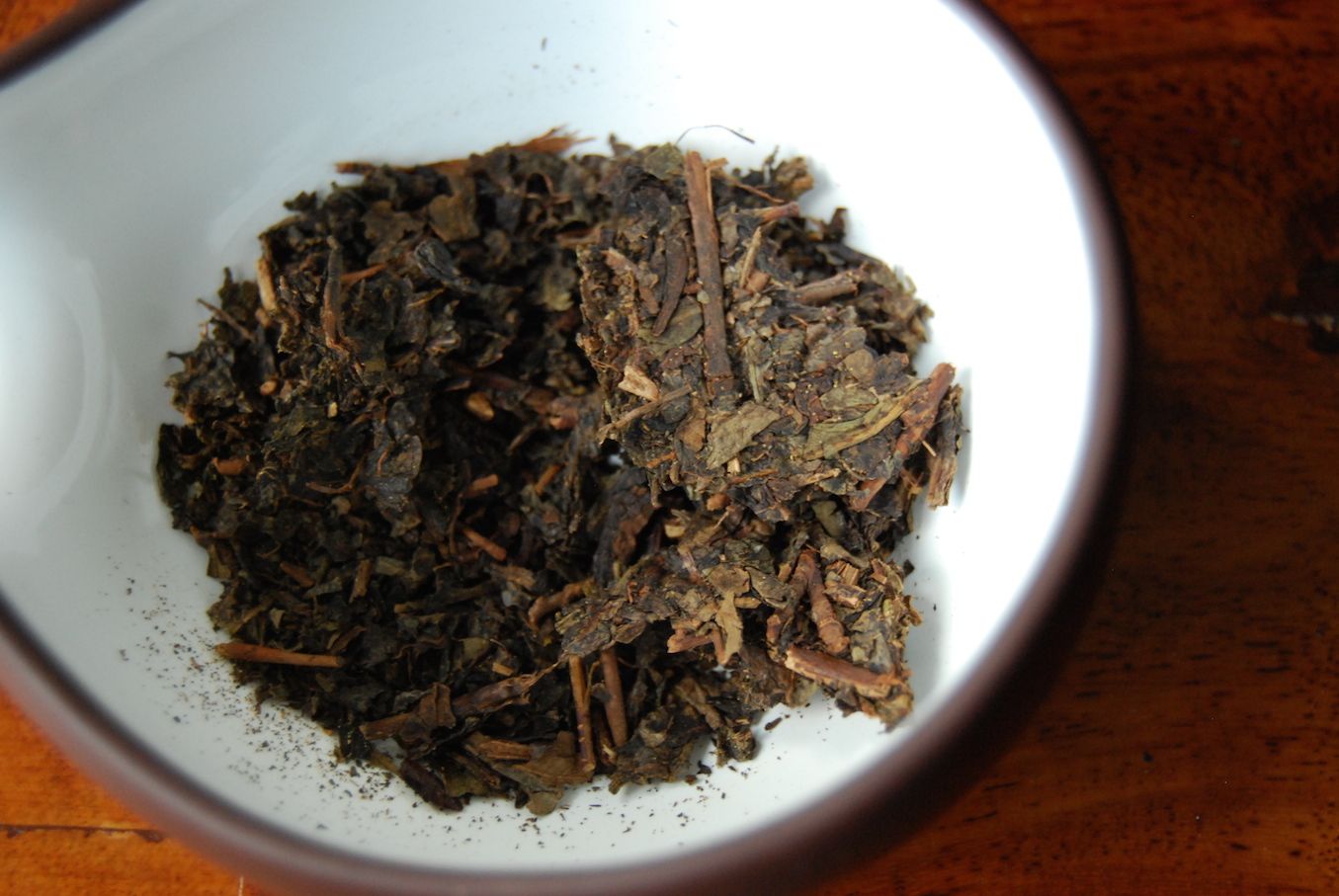Today, I would like to introduce you to a friend of mine who is a bit... "special". The appearance will terrify you, perhaps, but I think that you, as did I, will grow to love her. Perhaps love her a bit too much. Let us not get ahead of ourselves.
Before the "main event" today, I warmed up the cockles of the empty, barren wasteland which is my heart with an old purchase from days gone by: the 1998 "Jiaji" tuocha from Good Ol' Dayi ("MAKIN' THE SHENGPU LIKE MAMA USED TO MAKE").
You are a clever one, Gentle Reader, and so you will have already seen my annotation in the above image: I bought this tuocha from "5000friend", which is an eBay vendor of some significant repute.
Many words have been used to describe "5000friend": these include, but are not limited to, thief, scumbag, blackguard, mountebank, racketeer, rancid burglar from beyond the ninth gate, and (my personal favourite) "douchenozzle". 5000friend shot to internet fame by selling Late Qing dynasty ("Late Qing dynasty") teapots that were rubbed with what can only be described as cheap shoepolish. So it is said. I was never a big buyer on the whole teapots-covered-in-cheap-shoepolish scene, and so didn't sample the delights of their product range, but the stories were chucklesome and enmirthenating to the max.
Being a suquer for punishment, I bought a bunch of "1998" tuocha from them, but it all turned out well. I have no idea whether or not the tea is really Dayi (or even if Dayi were branding their tuocha in this manner back in 1998), but I live by the famous saying "Who cares if it's a fake sold by some dude who rubs cheap shoepolish into a teapot - if it tastes so right, it can't be wrong". I think perhaps Shakespeare originally wrote that.
The original article for this tea is here.
My humourous regions are enlivened when I check my tea spreadsheet (yes, I have a spreadsheet) to learn that this tea cost £8 back in 2007. That probably means that, in 2007 prices, it was 15 USD. Those were the days, when British currency was about 1:2 with the US dollar. I miss those days plentifully.
I have a big old tube of these tuocha, and so I am really hoping that they are aging properly. The soup, once a heavy yellow, is now a heavy orange, and LO, Hobbes did breathe a sigh of relief to see that some aging had occurred.
The result is long-lasting and very throaty, like a nasty virus. It has a plurality of HUIGANS, and these latter last rather a long time, too. This is one of just a few teas that I have aged from "middle age" to something approaching actually "aged"; the majority of the teas on our shelves were either bought "aged" or which were bought young and are now "middle aged". So, to see this little fella developing nicely is a welcome experience. "Exceptional length", I seem to have recorded, and exceptional length can only be a good thing.
"This is quite complex", observes my dear wife, as she passes and tastes a cup.
I promised you something ugly, and here it is. Let's get nasty.
This gold brick looks soooo old-fashioned, in the classical Chinese 80s-90s aesthetic that it actually seems appealing, in a kitsch way. It is the 2011 "Jinxiangyi".
Xiangyi [SHEE'ANG-YEE] is a brand, and so "Jinxiangyi" is, would you believe it, "Gold Xiangyi".
Xiangyi, the brand, is a product of HUNAN YIYAN FUCHA. This is not pu'ercha. Hold onto your hats and hide your daughters, because this is rancid brick tea from Hunan.
You can't say that you haven't been warned.
We have Chinese, yes. We have... Tibetan, by the look it (help me out here, cunning linguists). We also have... that strange script that reminds me of Arabic that, if it isn't actually Arabic (and I am unable to tell) is that language that crops up repeatedly when dealing with Muslim minorities in the PRC. It's probably Arabic. Never ask a scientist to get linguistic.
What's so nasty about Hunan brick-tea, then? Well, Gentle Reader, steel yourselves for the images above and below, which show copious quantities of mould. They spray it on, they do all sorts of voodoo, and the result is intentional mould-encrusted tealeaves.
These are spores. SPORES! From China! Heaven knows what's happening down there. I can see the FDA's blood pressure rising already.
It really is carnage down in this brick. We've got mould, we've got smacked-up branches, it wouldn't be surprising if I found a severed rat's tail in there. This stuff is really, really dirty.
What better way to start the day? Fire up the kettle and let's get filthy, methinks to myself.
This tea is really addictive. I mean addictive, this tea leaves you shivering and tremourous, and craving more. It is the crack cocaine of the Chinese tea market, except it is so dirty that you would be hard-pressed to find any self-respecting dealer of narcotics peddling such wares.
Except, it's hugely popular. This rancid, unholy concoction is a regional speciality. Like herpes in Bangkok, perhaps, but a regional speciality nonetheless.
I really love it. (The tea that is, not the herpes from Bangkok.) It is big, orange, heavy, and so-so-so powerful that it makes Bulangshan pu'ercha look like a gentle shoulder-massage from a nubile concubine.
This tea is very definitely not a nubile concubine. It is something more akin to a tattoo-covered, salty, hairy mistress of the night, who came up the wrong side of the law once too often. It is not nice, in any measurable sense, and yet it so plainly addictive that I am beginning to question my own sanity, like a protagonist in a story by H.P. Lovecraft.
When Cthulhu rises from beneath the waves, and Shub-Niggurath (the Goat with a Thousand Young) gets his Shub on, their beverage of choice will UNDOUBTEDLY be the 2011 Jinxiangyi. This is the kind of tea that the words "eldritch" and "cyclopean" were invented to describe. This is like the twised half-sister of liu'an, which was passed through a dimensional portal only to be stranded in the infinite abyss for a millenium, infused with the screams of the howling daemons that inhabit that nether-realm, before being returned to present-day earth for immediate consumption.
If you like danger, you need to try the 2011 Xiangyi. I am currently trying to find a vendor to provide this in quantity, and preferably one that does not have ties to a mystical cult dedicated to bringing about the resurrection of an ancient race of intergalactic, planet-eating deities.
However, if the choice is between not having this tea and funding the aforementioned apocalyptic cult, then SIGN ME UP, cultists, and get my robes and head-dress ready.
I must haves me my Xiangyi.
Ph'nglui mglw'nafh Cthulhu R'lyeh wgah'nagl fhtagn.













There's an Aliexpress vendor, "Rainbow wang's store," that sells the 2011 Jinxiangyi. (It's stored under "Women's clothing"!) $26.6 per brick, free overseas shipping. No idea whether the vendor is reputable or not, or whether the price is justifiable.. They have the 2012 version too.
ReplyDeleteI'm a little bit tempted myself, but is this moldy stuff really safe to consume? Perhaps having to ask that question is itself proof that one is not fit to consume this mighty nectar.
I will point out that one day, after drinking some Xiangyi that had been left overnight, I had VIOLENT vomiting for 24 hours afterwards. However, that is a small price to pay for such a tea experience.
ReplyDeleteThank you for suggesting Rainbow Wang - I feel obliged to buy from anyone brave enough to use such a name. I will report back in due course...
Toodlepip,
Hobbes
Yikes violent vomiting is no bueno. I can say I have been drinking some moldy 2004 "Three Cranes" Jin Hua Liubao Tea and its growing on me. It's quite moldy.. little golden spores (Jin Hua) all over it.
ReplyDeleteAlso tried 2008 Anhua Shi Liu Liang Cha from Hunan (also very moldy) which smelled exactly like my great grandmother's root cellar. It was actually pretty good to.
sorry forgot to leave the name of the vendor.. www.chawangshop.com has lots of moldy teas under their Hei Cha selection. I couldn't find Xiangyi though.
ReplyDeleteThe scent of root cellar is underrated! Thank you for the recommendation; I like to buy from Honza at Chawangshop, and will peruse their "mouldy tea" catalogue...
ReplyDeleteToodlepip,
Hobbes
You bet.. I will probably get more of the grandmother root cellar tea.. it was pretty awesome. The sample I got was a bit mashed up so the whole chunks I pulled out brewed best. Did a quick hot brew and it made a clean sweet yellow almost mushroomy and savory brew. Good stuff!
ReplyDeleteThe fourth language there is Mongolian.
ReplyDeleteI dunno about the idea of tossing "jin hua" spores in my gaiwan... I don't even like chrysanthemum tea. That said, I do enjoy mitey cheese and wild yeast beers, maybe I'm just being close-minded!
Mongolian! I would not have guessed.
ReplyDeleteToodlepip,
Hobbes
Mold is apparently Eurotium cristatum.. I don't know a lot about it but haven't had any ill effects from drinking it as of yet. It seems to lend the tea a nice smooth sweet flavor.
ReplyDeleteThe way I look at it its not much different than eating moldy cheese. Which is pretty awesome in my book.
Well, there is mould and then there is mould. :)
ReplyDeleteToodlepip,
Hobbes
I have had luck supplying this(yellow 'blooms' and all) from Jim at the Puerh Shop for a reasonable USA price.
ReplyDeleteThanks for this post. I enjoy your art here.
Puerhshop it is, then - thank you!
ReplyDeleteToodlepip,
Hobbes
While it seems that Puerhshop sells basic Xiangyi, it is not the Golden Xiangyi, as far as I can tell, but a more basic brick. Am I missing the Jin Xiangyi on their product listing?
ReplyDeleteWith thanks,
Hobbes